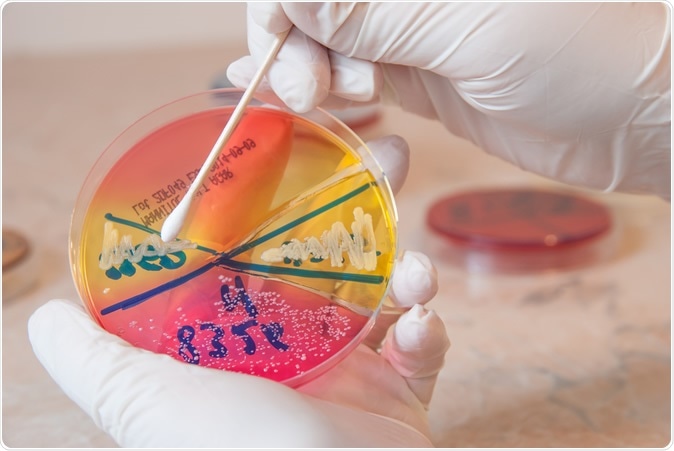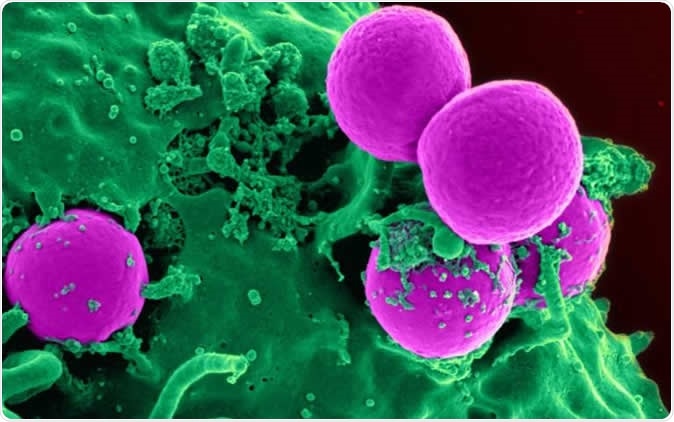A new antimicrobial coating that can be activated by light has been reported by researchers in the journal Nature Communications, in March 2020. The coating can be used to prevent transmission from computer and phone screens and keyboards, the inside of catheters, and breathing tubes. All these are significant routes of healthcare-associated infections (HCAIs).

Sterile swab and Staphylococcus aureus bacteria on petri dish. Image Credit: Zaharia Bogdan Rares
The current study shows, for the first time, a light-activated coating that can kill bacteria on its surface when activated by dim ambient light of 300 Lux, similar to the lighting in waiting rooms and wards. This is a big step forward from the older type of coating that could be activated only by very strong light, on the order of 3,000 Lux, similar to that found in operating rooms.
Formerly, researchers have found antibacterial activity with nanosilver, titanium dioxide, and other metals. Silver nanoparticles release the metal ions that kill bacteria and yeast.

Human neutrophil ingesting MRSA (Source: National Institutes of Health (NIH))
The discovery
The new coating depends on the presence of tiny clumps of chemically modified gold, embedded with the microbicidal dye crystal violet in a polymer. Describing the properties of these two bacterial poisons, researcher Gi Byoung Hwang says, “Dyes such as crystal violet are promising candidates for killing bacteria and keeping surfaces sterile as they are widely used to disinfect wounds. When exposed to bright light, they create reactive oxygen species, which in turn kill bacteria by damaging their protective membranes and DNA. This is amplified when they are paired with metals such as silver, gold, and zinc oxide.”
Similar bactericidal coatings depend on exposure to ultraviolet light, which is toxic to human cells, or to very intense light, which is challenging to attain. On the other hand, the current coating is extremely effective, according to co-researcher Ivan Parkin, who describes it as “killing both S. aureus and E. coli in ambient light, making it promising for use in a variety of healthcare environments.”
The researchers came from different streams, including chemists, chemical engineers, and microbiologists. The new coating is generated by a method designed to be easily scaled up or down, and has been tested for its activity against these pathogens under different light conditions in parallel with controls.
The surfaces of different objects were coated with either this coating or a control coating. Then a test dose of either of these bacterial species was inoculated on them at 100,000 colony-forming units (CFU)/ml. The samples were then kept either in the dark or the white light, at 200-429 Lux.
The findings
The scientists found that the control coating, which consisted of crystal violet in a polymer, failed to kill either of these species in ambient light. Still, the new coating showed potent bactericidal activity, reducing the concentration of S. aureus by 3.3 log after 6 hours, and that of E. coli by 2.8 log after 24 hours.
The increased resistance of E. coli did not go unnoticed. Explains a third researcher Elaine Allan, “E. coli was more resistant to the bactericidal coating than S. aureus as it took longer to achieve a significant reduction in the number of viable bacteria on the surface. This is presumably because E. coli has a cell wall with a double membrane structure, whereas S. aureus only has a single membrane barrier.”
The secret weapon
Without really going very deep, the researchers also discovered the mechanism by which the coating achieved its strong bactericidal activity. In essence, it generates hydrogen peroxide, which is a disinfectant used in everyday applications such as cleaning off blood stains from clothing and to clean contact lenses.
Hydrogen peroxide works directly on bacteria by disrupting the chemical structure of the cell membrane. This explains why organisms with a thicker protective structure or layered protection tend to resist the action of the coating for a more extended period.
The key to the whole process is the minute amount of gold clusters. Senior author Asterios Gavrillidis comments, “The gold clusters in our coating are key to generating the hydrogen peroxide, through the action of light and humidity. Given the clusters contain only 25 atoms of gold, very little of this precious metal is required compared to similar coatings, making our coating attractive for wider use.”
Implications
The team of researchers first reported a similar gold-crystal violet-based coating in 2014. This is based on a silicone framework that is then allowed to swell by exposing it to an organic solvent. The silicone is then permeable to the microbicidal dye methylene blue and to gold, which migrates throughout it. This silicone is finally dipped in a crystal violet bath, which causes that dye to adhere to the surface. The coating was able to kill any bacterium placed on it within 3-6 hours when left under an ordinary fluorescent light bulb. Even in the dark, astonishingly, it still killed off microbes, only it took around 18 hours this time around, making it the first-ever light-activated antibacterial substance to perform so well under dark conditions.
These two reports on light-activated coatings could represent invaluable progress in the prevention of HCAIs if widely used to decontaminate all kinds of routinely touched objects and surfaces in a hospital or other healthcare facility.
Source:
Journal reference:
Hwang, G.B., Huang, H., Wu, G. et al. Photobactericidal activity activated by thiolated gold nanoclusters at low flux levels of white light. Nat Commun 11, 1207 (2020). https://doi.org/10.1038/s41467-020-15004-6